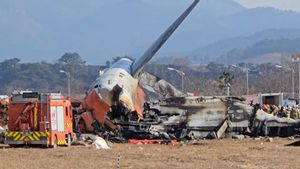JAKARTA - The Ministry of Energy and Mineral Resources (ESDM) is committed to supporting the reduction of gas flares or gas flares in oil and gas business activities in order to achieve the carbon neutral target by 2060.
"Indonesia has set a target to support net zero emissions by 2060 or sooner, so it is necessary to mitigate greenhouse gas emissions in oil and gas business activities, one of which is by managing gas flares," said the Oil and Gas Inspector Young Expert at the Directorate General of Oil and Gas at the Ministry of Energy and Mineral Resources. Chitra Ria Ariska was reported by ANTARA, Tuesday, August 2.
Currently, said Chitra, the Ministry of Energy and Mineral Resources has compiled a roadmap for reducing gas flares from 2020 to 2024.
In 2020, the Ministry of Energy and Mineral Resources will identify coordination efforts with oil and gas stakeholders and prepare commitments for zero routine flaring.
The Ministry of Energy and Mineral Resources has also strengthened regulations through revisions to regulations regarding the implementation of gas flaring in 2021, preparation of accurate baseline data related to flaring in 2022, mapping of gas flaring reductions in 2023, and clustering of gas flaring reductions by identifying the source chain and potential utilization of flaring gas and determine the pooling system.
Flare gas is gas produced by oil and gas exploration and exploitation activities that will be burned in a flare continuously or not continuously under routine or non-routine conditions.
Emissions produced by gas flares are mostly carbon dioxide.
Gas flaring, especially in the downstream oil and gas sector, is carried out for safety, for example the burning of gas flares for cleaning, testing, testing for safety systems and burning gas flares for environmental safety.
There is also the burning of gas flares from additional gas as fuel for the combustion of flare gases containing impurity gases to maintain the flame.
"In addition, gas flare from low pressure gas and/or flare gas combustion with an average impurity gas content greater than 50 mole percent which based on technical and economic studies has not or cannot be utilized," said Chitra.
Furthermore, Chitra said, gas flares can be used to flow back into the fuel system at production facilities, so that it can save fuel, generate electricity, produce Compressed Natural Gas (CNG), Liquefied Natural Gas (LNG) as an ingredient to produce methanol and ammonia, gas injection for Enhanced Oil Recovery (EOR) activities, to increase the amount of oil removal in old oil and gas blocks.
The volume of gas flare for upstream and downstream oil and gas activities reached 133.10 MMSCFD.
Meanwhile, the utilization of flare gas both upstream and downstream reached 342.97 MMCSFD.
Gas flaring management activities in the upstream oil and gas sub-sector during 2018-2021, there was a decrease in gas flaring accompanied by an increase in the use of gas flaring in the upstream oil and gas sector.
Meanwhile, downstream oil and gas tends to fluctuate and along with the optimization of the production process the number is decreasing.
Until the third quarter of 2021, the government's policy to reduce greenhouse gas emissions has been carried out by the use of gas flares by 50 KKKS upstream oil and gas and seven Oil and Gas Downstream Business Entities.
The total utilization of gas flare for self-interest is 287 MMSCFD from 50 upstream KKKS and 43 MMSCFD from seven downstream business entities.
"Thus, the total gas flare utilized from upstream and downstream oil and gas activities is 342 MMSCFD," concluded Chitra.
The English, Chinese, Japanese, Arabic, and French versions are automatically generated by the AI. So there may still be inaccuracies in translating, please always see Indonesian as our main language. (system supported by DigitalSiber.id)












